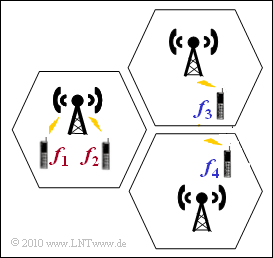Exercise 4.4: Cellular UMTS Architecture
Um ein flächendeckendes Netz mit geringer Sendeleistung und ausreichender Frequenzökonomie zu ermöglichen, werden bei UMTS – wie auch bei "GSM" – Funkzellen eingerichtet.
Für einfache Systemuntersuchungen geht man dabei von hexagonalen Zellen wie in der Grafik angedeutet aus. In Realität sind die Funkzellen unterschiedlich groß und zudem an die vorliegende Topologie und die Infrastruktur des Versorgungsgebietes angepasst.
Es gibt drei unterschiedliche Typen von Funkzellen mit einem hierarchischen Aufbau:
- ${\rm Makrozellen}$: 4 bis 6 km Durchmesser, Geschwindigkeiten bis zu 500 km/h erlaubt.
- ${\rm Mikrozellen}$: 1 bis 2 km Durchmesser, maximal zulässige Geschwindigkeit 120 km/h.
- ${\rm Pikozelle}$: Durchmesser bis 100 m, viele Teilnehmer, extrem hohes Datenaufkommen.
Eine Makrozelle kann möglicherweise eine Vielzahl von Mikro– und Pikozellen überlagern. Für eine Mikrozelle beträgt die maximale Datenrate $384 \ \rm kbit/s$ für die maximale Geschwindigkeit von $120 \ \rm km/h$. Mit den maximal zulässigen Datenraten in einer Makrozelle und einer Pikozelle beschäftigt sich die Teilaufgabe (1).
Im Zusammenhang mit der zellularen Struktur von UMTS werden häufig Begriffe verwendet, die in dieser Aufgabe erklärt werden sollen:
- Intrazellinterferenz und Interzellinterferenz,
- Zellatmung,
- Handover.
Hints:
- This exercise belongs to the chapter "UMTS Network Architecture".
- Reference is made in particular to the pages "Access level architecture" und "Handover in UMTS".
Questions
Solution
(1) Only the last statement is correct:
- Since the range of radio signals decreases with increasing frequency at the same transmission power, the radio cells at UMTS (carrier frequency around $2 \ \rm GHz$) are significantly smaller than at GSM (in the D-network around $900 \ \rm MHz$).
- The maximum data rates for UMTS (which are more theoretical limits) are as follows for
- a macro cell up to $144 \ \rm kbit/s$,
- a picocell up to $2 \ \rm Mbit/s$.
(2) Correct are all statements:
- The two definitions for intracell and intercell interference are correct.
- Applying these to the scenario at hand (graph on the information page), we see.
- Intracell interference for $f_{1} = f_{2}$,
- Intercell interference for $f_{3} = f_{4}$.
- Intracell interference is more severe than Intercell interference because of the usually smaller distance of the interferers from the receiver, that is, it causes a smaller CIR (carrier-to-interference ratio).
(3) Correct statements 1 and 2 are:
- Cellular respiration is accurately described by the first two statements.
- With fewer participants now transmitting on a frequency, the negative influence of intracell interference is reduced.
- The participants in neighboring cells transmit on other frequencies and thus interfere much less.
- An alternative to cell breathing would be to maintain the cell size but reduce the transmit power of all participants within the cell, but this also means a reduction in the reception quality.
- The last proposed solution is simply wrong.
(4) Correct are all statements:
- For example, downlink data is split in the Radio Network Controller (RNC), broadcast over the participating "Node Bs", and reassembled in the mobile station.
- With soft handover, a mobile can communicate with up to three base stations simultaneously.
- This variant is of course superior to Hard Handover, but also involves greater effort.
